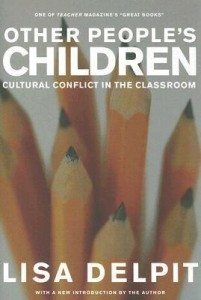Lisa Delpit investigates language diversity in the classroom and the ways it is frequently suppressed by uneven power dynamics.

Lisa Delpit investigates language diversity in the classroom and the ways it is frequently suppressed by uneven power dynamics.

Learning to orally produce an alternate form is not principally a function of cognitive analysis, thereby not ideally learned from protracted rule-based instruction and correction. Rather, it comes with exposure, comfort level, motivation, familiarity, and practice in real communicative contexts. Those who have enjoyed a pleasant interlude in an area where another dialect of English is spoken may have noticed a change in their own speech. Almost unconsciously, their speech has approached that of those native to the area. The evidence suggests that had these learners been corrected or drilled in the rules of the new dialect, they probably would not have acquired it as readily. …
The so-called affective filter is likely to be raised when the learner is exposed to constant correction. Such correction increases cognitive monitoring of speech, thereby making talking difficult. To illustrate with an experiment anyone can try, I have frequently taught a relatively simple new “dialect” in my work with preservice teachers. In this dialect, the phonetic element “iz” is added after the first consonant or consonant cluster in each syllable of a word. {Teacher becomes tiz-ea-chiz-er and apple, iz-ap-piz-le.) After a bit of drill and practice, the students are asked to tell a partner why they decided to become teachers. Most only haltingly attempt a few words before lapsing into either silence or into “Standard English,” (Usually to complain about my circling the room to insist that all words they utter be in the new dialect. During a follow-up discussion, all students invariably speak of the impossibility of attempting to apply rules while trying to formulate and express a thought. Forcing speakers to monitor their language for rules while speaking, typically produces silence. …
What should teachers do about helping students acquire an ‘additional oral form? First, they should recognize that the linguistic form a student brings to school is intimately connected with loved ones, community, and personal identity. To Suggest that this form is “wrong” or, even worse, ignorant, is to suggest that something is wrong with the student and his or her family. On the other hand, it is equally important to understand that students who do not have access to the politically popular dialect form in this country, that is, Standard English, are-less likely to succeed economically than their peers who do. How can both realities be embraced?
Teachers need to support the language that students bring to school, provide them input from an additional code, and give them the opportunity to use the new code in a nonthreatening, real communicative context. Some teachers accomplish this goal by having groups of students create bidialectal dictionaries of their own language form and Standard English. Others have had students become involved with standard forms through various kinds of role-play. For example, memorizing parts for drama productions will allow students to “get the feel” of speaking Standard English while not under the threat of correction. Young students can create puppet shows or role-play cartoon characters. (Many “superheroes” speak almost hypercorrect Standard English!) Playing a role eliminates the possibility of implying that the child’s language is inadequate, and suggests, instead, that different language forms are appropriate in different contexts. Some other teachers in New York City have had their students produce a news show every day for the rest of the school. The students take on the persona of some famous newscaster, keeping in character as they develop and read their news reports. Discussions ensue about whether Walter Cronkite would have said it that way, again taking the focus off the child’s speech.
Delpit, Lisa. 2006. Other People’s Children: Cultural Conflict in the Classroom. New York: New Press. pp. 48-53. || Amazon || WorldCat